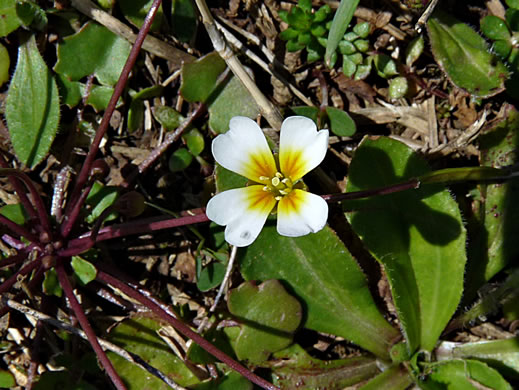Spermatophytes (seed plants): Angiosperms (flowering plants): Eudicots: Core Eudicots: Rosids: Malvids: Brassicales
WEAKLEY'S FLORA OF THE SOUTHEASTERN US (4/24/22):
Leavenworthia exigua var. exigua
FAMILY
Brassicaceae
Go to FSUS key
Dig deeper at SERNEC, a consortium of southeastern herbaria.
SYNONYMOUS WITH
PLANTS NATIONAL DATABASE:
Leavenworthia exigua var. exigua
FAMILY
Brassicaceae
INCLUDED WITHIN Floristic Synthesis of North America. BONAP (Kartesz, 2021)
Leavenworthia exigua
INCLUDED WITHIN Flora of North America
Leavenworthia exigua
COMMON NAME:
Tennessee Gladecress, Least Glade-cress
To see larger pictures, click or hover over the thumbnails.
Richard and Teresa Ware rtw_l_exigua_exigua
April
Flowers solitary at the top of a leafless stalk, opening only on sunny days, per Field Guide to the Rare Plants of Georgia (Chafin, 2007).
Richard and Teresa Ware rtw_l_exigua_exigua2
August
Petals shallowly notched at the tip, white with a yellow base, very fragrant, per Field Guide to the Rare Plants of Georgia (Chafin, 2007).
WEAKLEY'S FLORA OF THE SOUTHEASTERN US (4/24/22):
Leavenworthia exigua var. exigua
FAMILY
Brassicaceae
SYNONYMOUS WITH
PLANTS NATIONAL DATABASE:
Leavenworthia exigua var. exigua
FAMILY
Brassicaceae
INCLUDED WITHIN
Floristic Synthesis of North America. BONAP (Kartesz, 2021)
Leavenworthia exigua
INCLUDED WITHIN
Flora of North America
Leavenworthia exigua
If a search such as "Carex leptalea var. leptalea" doesn't deliver the results you want, try "Carex leptalea".
Or, to minimize chances of a misspelling, try just "Carex le".
Less is more: If "pencil flower" doesn't deliver the results you want, try "pencil".



